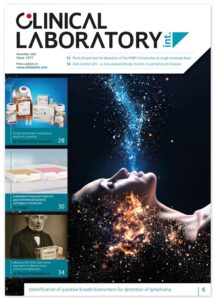Researchers’ new technique improves accuracy, ease of cancer diagnosis
A team of researchers from UCLA and Harvard University have demonstrated a technique that, by measuring the physical properties of individual cells in body fluids, can diagnose cancer with a high degree of accuracy.
The technique, which uses a deformability cytometer to analyse individual cells, could reduce the need for more cumbersome diagnostic procedures and the associated costs, while improving accuracy over current methods. The initial clinical study analysed pleural fluid samples from more than 100 patients.
Pleural fluid, a natural lubricant of the lungs as they expand and contract during breathing, is normally present in spaces surrounding the lungs. Medical conditions such as pneumonia, congestive heart failure and cancer can cause an abnormally large buildup of the fluid, which is called a pleural effusion.
When cytopathologists screen for cancer in pleural effusions, they perform a visual analysis of prepared cells extracted from the fluid. Preparing cells for this analysis can involve complicated and time-consuming dyeing or molecular labelling, and the tests often do not definitively determine the presence of tumour cells. As a result, additional costly tests often are required.
The method in the UCLA–Harvard study, developed previously by the UCLA researchers, requires little sample preparation, relying instead on the imaging of cells as they flow through in microscale fluid conduits.
Imagine squeezing two balloons, one filled with water and one filled with honey. The balloons would feel different and would deform differently in your grip. The researchers used this principle on the cellular level by using a fluid grip to ‘squeeze’ individual cells that are 10,000 times smaller than balloons—a technique called ‘deformability cytometry.’ The amount of a cell’s compression can provide insights about the cell’s makeup or structure, such as the elasticity of its membrane or the resistance to flow of the DNA or proteins inside it. Cancer cells have a different architecture and are softer than healthy cells and, as a result, ‘deform’ differently.
Using deformability cytometry, researchers can analyse more than 1,000 cells per second as they are suspended in a flowing fluid, providing significantly more detail on the variations within each patient’s sample than could be detected using previous physical analysis techniques.
The researchers also noted that the more detailed information they obtained improved the sensitivity of the test: Some patient samples that were not identified as cancerous via traditional methods were found to be so through deformability cytometry. These results were verified six months later.
‘Building off of these results, we are starting studies with many more patients to determine if this could be a cost-effective diagnostic tool and provide even more detailed information about cancer origin,’ said Dino Di Carlo, associate professor of bioengineering at the UCLA Henry Samueli School of Engineering and Applied Science and a co-principal investigator on the research. ‘It could help to reduce laboratory workload and accelerate diagnosis, as well as offer doctors a new way to improve clinical decision-making.’ University of California – Los Angeles


